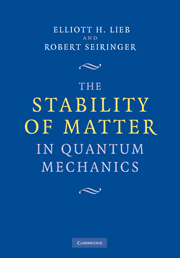Book contents
- Frontmatter
- Contents
- Preface
- 1 Prologue
- 2 Introduction to Elementary Quantum Mechanics and Stability of the First Kind
- 3 Many-Particle Systems and Stability of the Second Kind
- 4 Lieb–Thirring and Related Inequalities
- 5 Electrostatic Inequalities
- 6 An Estimation of the Indirect Part of the Coulomb Energy
- 7 Stability of Non-Relativistic Matter
- 8 Stability of Relativistic Matter
- 9 Magnetic Fields and the Pauli Operator
- 10 The Dirac Operator and the Brown–Ravenhall Model
- 11 Quantized Electromagnetic Fields and Stability of Matter
- 12 The Ionization Problem, and the Dependence of the Energy on N and M Separately
- 13 Gravitational Stability of White Dwarfs and Neutron Stars
- 14 The Thermodynamic Limit for Coulomb Systems
- List of Symbols
- Bibliography
- Index
2 - Introduction to Elementary Quantum Mechanics and Stability of the First Kind
Published online by Cambridge University Press: 20 December 2010
- Frontmatter
- Contents
- Preface
- 1 Prologue
- 2 Introduction to Elementary Quantum Mechanics and Stability of the First Kind
- 3 Many-Particle Systems and Stability of the Second Kind
- 4 Lieb–Thirring and Related Inequalities
- 5 Electrostatic Inequalities
- 6 An Estimation of the Indirect Part of the Coulomb Energy
- 7 Stability of Non-Relativistic Matter
- 8 Stability of Relativistic Matter
- 9 Magnetic Fields and the Pauli Operator
- 10 The Dirac Operator and the Brown–Ravenhall Model
- 11 Quantized Electromagnetic Fields and Stability of Matter
- 12 The Ionization Problem, and the Dependence of the Energy on N and M Separately
- 13 Gravitational Stability of White Dwarfs and Neutron Stars
- 14 The Thermodynamic Limit for Coulomb Systems
- List of Symbols
- Bibliography
- Index
Summary
In this second chapter we will review the basic mathematical and physical facts about quantum mechanics and establish physical units and notation. Those readers already familiar with the subject can safely jump to the next chapter.
An attempt has been made to make the presentation in this chapter as elementary as possible, and yet present the basic facts that will be needed later. There are many beautiful and important topics which will not be touched upon such as self-adjointness of Schrödinger operators, the general mathematical structure of quantum mechanics and the like. These topics are well described in other works, e.g..
Much of the following can be done in a Euclidean space of arbitrary dimension, but in this chapter the dimension of the Euclidean space is taken to be three-which is the physical case-unless otherwise stated. We do this to avoid confusion and, occasionally, complications that arise in the computation of mathematical constants. The interested reader can easily generalize what is done here to the Rd, d >3 case. Likewise, in the next chapters we mostly consider N particles, with spatial coordinates in R3, so that the total spatial dimension is 3N.
A Brief Review of the Connection Between Classical and Quantum Mechanics
Considering the range of validity of quantum mechanics, it is not surprising that its formulation is more complicated and abstract than classical mechanics. Nevertheless, classical mechanics is a basic ingredient for quantum mechanics. One still talks about position, momentum and energy which are notions from Newtonian mechanics.
- Type
- Chapter
- Information
- The Stability of Matter in Quantum Mechanics , pp. 8 - 30Publisher: Cambridge University PressPrint publication year: 2009



